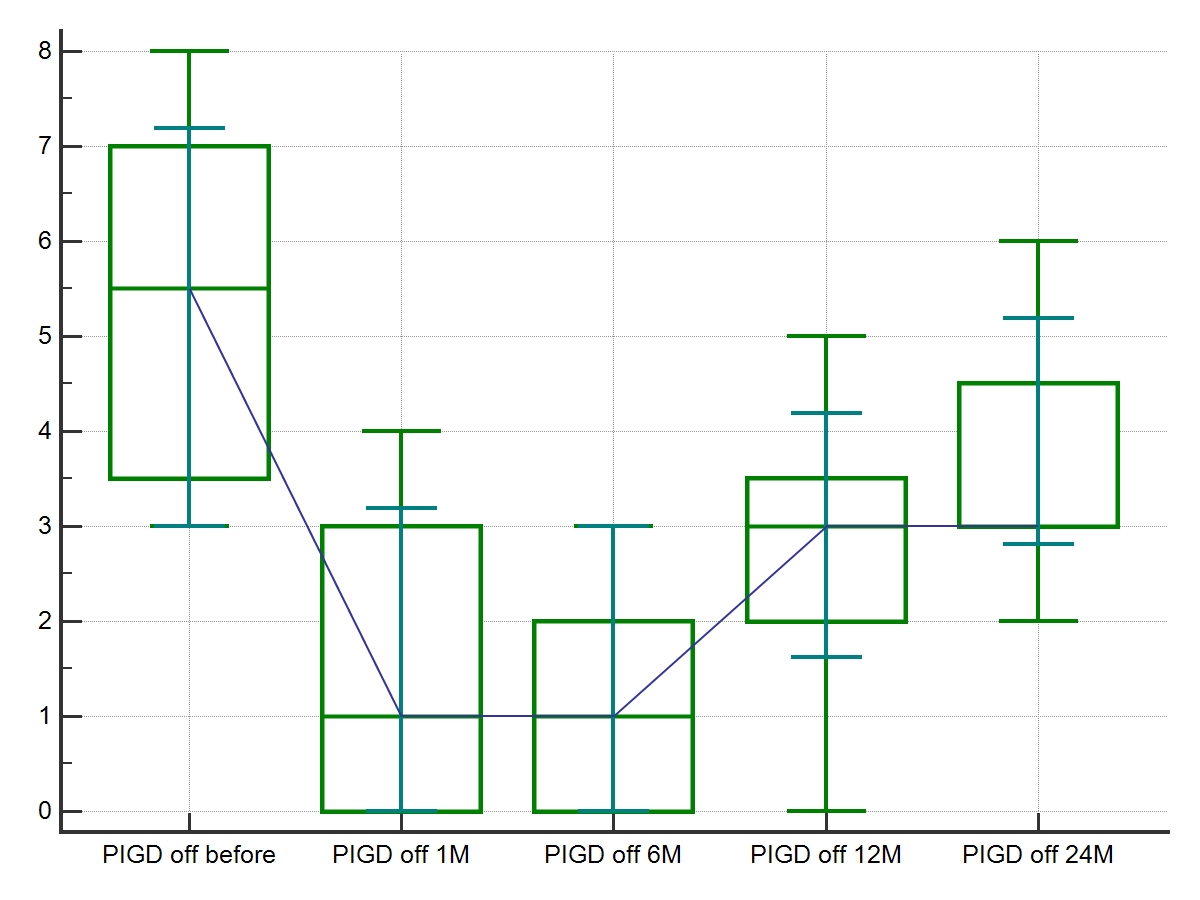Category: Parkinson's Disease: Neurophysiology
Objective: Quality of life (QOL) and activity of daily living (ADL) in PD patients depends on the severity of motor disorders, including changes of postural function (PF). DBS has a positive effect on the rigidity, hypokinesia and tremor, but different effects on the patients PF[1,2,3]
Background: To assess of PF changes and their effect on QoL and ADL in PD patients during DBS
Method: We examined 55 PD patients during DBS. 30 male and 25 female, median age 56[54;62] years, 46 patients–II stage of H&Y, 8–III, 1-IV. 45 patients with DBS STN, 8 – DBS GPi, 2 – DBS Vim. We used PDQ-39 and Shwab&England to assess QOL and ADL. A comprehensive indicator PIGD was used to assess the PF. It consists of score number 13, 14, 15, 29, 30 items of UPDRS. Romberg’s test (RT) we conducted on stabiloanalizator with biofeedback
Results: Statistically significant difference by Friedman ANOVA of PIGD in off-med during 2 years of DBS ANOVA X²=10,05, p<,00004 [figure 1].
A correlation analysis – Spearman’s non-parametric rank correlation (SRC) was carried out between the PIGD in off-med and PDQ-39 before (rs= 0,43, р=0,001), then 1 m (rs= 0,40, р=0,006), 6 m (rs= 0,48, р=0,02); between PIGD in off-med and Shwab-England off-med before (rs= -0,46, р=0,0003), 1 m (rs= -0,52, р=0,0002), 1 y (rs= 0,38, р=0,03) of DBS.
The SRC was carried out between PIGD in on-med on-stim and the average radius of the pressure center (PC) deviation (rs=0,57, р=0,04), the mean rate of the PC (rs=0,86, р=0,0002), pressure area (PA) – stabilogram (rs=0,63, р=0,02), the mean rate of PA change (rs=0,80, р=0,001), line rate in frontal plane (rs=0,77, р=0,002), line rate in sagittal plane (rs=0,87, р=0,0001), balance function quality (BFQ) (rs=- 0,83, р=0,0004) by RT after 2 y of DBS.
The SRC was carried out between PDQ-39 and PA of RT (rs=0,53, р=0,04) after 1 y of DBS, PDQ-39 and BFQ of RT (rs= -0,59, р=0,04) after 2 y of DBS
Conclusion: Reduced PIGD and revealed correlations with the values of PDQ-39, Shwab-England and Romberg test indicators confirm DBS positive effect on locomotor activity and quality of life in PD patients
References: 1. Bilateral subthalamic nucleus deep brain stimulation improves certain aspects of postural control in Parkinson’s disease, whereas medication does not / N. Shivitz [et al.] // Movement Disorders. – 2006. – Vol. 21, № 8. – P. 1088–1097. 2. Bilateral subthalamic nucleus stimulation improves balance control in Parkinson’s disease / S. Colnat-Coulbois [et al.] // J. of Neurology, Neurosurgery, and Psychiatry. – 2005. – Vol. 76, iss. 6. – P. 780–787. 3. Collomb-Clerc, A. Effects of deep brain stimulation on balance and gait in patients with Parkinson’s disease: a systematic neurophysiological review / A. Collomb-Clerc, M. L. Welter // Neurophysiology Clinique. – 2015. – Vol. 45, iss. 4/5. – P. 371–388.
To cite this abstract in AMA style:
A. Buniak, S. Likhachev. Impact of the postural function сhanges on quality of life and daily activity in patients with Parkinson’s disease during DBS [abstract]. Mov Disord. 2021; 36 (suppl 1). https://www.mdsabstracts.org/abstract/impact-of-the-postural-function-%d1%81hanges-on-quality-of-life-and-daily-activity-in-patients-with-parkinsons-disease-during-dbs/. Accessed December 25, 2025.« Back to MDS Virtual Congress 2021
MDS Abstracts - https://www.mdsabstracts.org/abstract/impact-of-the-postural-function-%d1%81hanges-on-quality-of-life-and-daily-activity-in-patients-with-parkinsons-disease-during-dbs/

